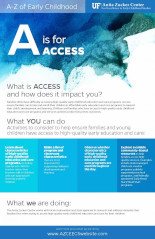A to Z’s of Early Childhood
The Science of Child Development and Learning
A is for Access
Families often need help finding and enrolling their children in an early childhood education and care program that is affordable, meets their needs, and that promotes children’s development and learning. Did you know there are local and national resources to help families locate and access needed early education and care arrangements?
Tips for Locating and Accessing Education and Care Programs
Tip #1 - Use online tools to search for available early childhood education and care providers.
Recent federal legislation has resulted in the development of a national search engine designed to help families find early childhood education and care options.
Tip #2 - When looking online, look for markers of quality.
Trustworthy online search tools display important information about the type and quality of services provided by early childhood education and care providers. Look for ratings of quality, whether or not the program is accredited by a reputable organization, and the program’s history of compliance with health and safety regulations.
Tip #3 - Contact your state or local Child Care Resource and Referral agency.
Child Care Resource and Referral agencies help families find early childhood education and care services. They have staff trained to answer families’ questions about early childhood education and care and to help families find resources that make services more affordable.
Tip #4 - Explore resources that help families afford high-quality early childhood education and care services.
Many states have state-managed voucher programs, public preschool programs, and federally sponsored Early Head Start/Head Start programs. These resources can help provide families with supports to access early education and care options.
What We Know About Access
The National Survey of Early Care and Education reported the availability of early childhood education and care services is lower for children birth to age 3 than for children who are older than 3. Only 36% of formal early childhood education and care programs provide care for children under age 1, 43% provide care for 1-year-olds, and 52% provide care for 2-year-olds.1
The most recent census report (2011) found that 32.9% of children under age 5 are enrolled in a formal early childhood education and care program.2
The National Center for Education Statistics reported that as of 2016, 58% percent of 4- and 5-year-old children attended formal early childhood education and care programs in the year prior to kindergarten entry.3
Parents whose children are enrolled in formal care experience lower work disruptions and increased job retention.4
Family-, friend-, and neighbor-provided care is reported to be the most common arrangement families use for their children when working.5,6 Families should be aware that this type of care is not regulated in the same way as more formal early childhood education and care programs.
What We Are Doing
The Anita Zucker Center is continuing to work with local communities and state agencies to research and address obstacles that families face when trying to access high-quality early childhood education and care for their children.
Download an A is for Access flyer and share it with your community today.
Learn More:
- Innovative Accessibility Index Helps Policy Makers Make Better Childcare Decisions
Learn more about Anita Zucker Center research scientist Dr. Herman Knopf’s “Child Care Access Index,” which documents state-by-state accessibility of quality child care. - Community Celebrates Opening of New CHILD Center
In June 2018, Gainesville’s Southwest Advocacy Group (SWAG), in partnership with the Anita Zucker Center and other community groups, opened the CHILD Center, an early learning center providing state-of-the art early care and education experiences. - The Sunshine Portal: Florida’s Early Childhood Integrated Data System
The Sunshine Portal was created in partnership with the Florida Division of Early Learning within the Florida Department of Education and is currently being used by local and state level policy makers in Florida to make data-informed decisions to improve supports and services for young children and families.
Other Resources
- Search for Child Care
ChildCare.gov is an online resource for parents and caregivers to help them find child care services in their area. - Find Child Care Resources in Your State
Find state-by-state child care services with this resource from ChildCare.gov. - 15 Must Haves For All Child Care Programs
Use this checklist when evaluating child care programs.
References
- National Survey of Early Care and Education Project Team. (2015). Fact sheet: Who is providing home-based early care and education? (OPRE Report No. 2015-43). Office of Planning, Research and Evaluation, Administration for Children and Families, U.S. Department of Health and Human Services. https://www.acf.hhs.gov/sites/default/files/documents/opre/hb_providers_fact_sheet_toopre_041715_508.pdf
- Laughlin, L. (2013). Who’s minding the kids? Child care arrangements: Spring 2011 (Current Population Reports, Report No. P70-135 ). United States Census Bureau. https://www2.census.gov/library/publications/2013/demo/p70-135.pdf
- Rathbun, A., & Zhang, A. (2016). Primary early care and education arrangements and achievement at kindergarten entry (NCES 2016-070). National Center for Education Statistics, U.S. Department of Education. https://nces.ed.gov/pubs2016/2016070.pdf
- Gordon, R. A., Kaestner, R., & Korenman, S. (2008). Child care and work absences: Trade-offs by type of care. Journal of Marriage and Family, 70(1), 239-254. https://doi.org/10.1111/j.1741-3737.2007.00475.x
- Boushey, H., & Wright, J. (2004). Working moms and child care (Data Brief No. 3). Center for Economic and Policy Research. http://www.cepr.net/documents/publications/child_care_2004.pdf
- Snyder, K., & Adelman, S. (2004). The use of relative care while parents work: Findings from the 1999 National Survey of America’s Families (Discussion Paper No. 04-09). The Urban Institute. https://www.urban.org/sites/default/files/publication/57851/311131-The-Use-of-Relative-Care-While-Parents-Work.PDF
Receive Additional Support
The complete 3R’s of Early Learning downloadable video recordings (including the A to Z’s of Early Childhood) for use in the field of childhood development to facilitate learning are available for purchase.
If you would like to purchase these resources or speak with a member of our team for help in providing professional development, please complete this contact form.

